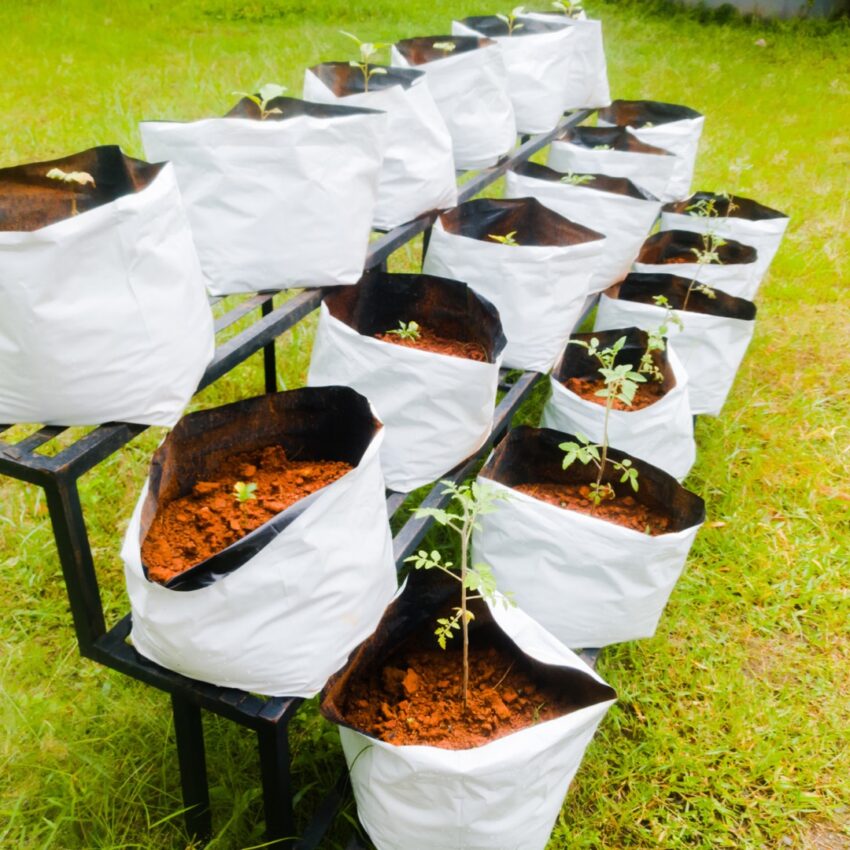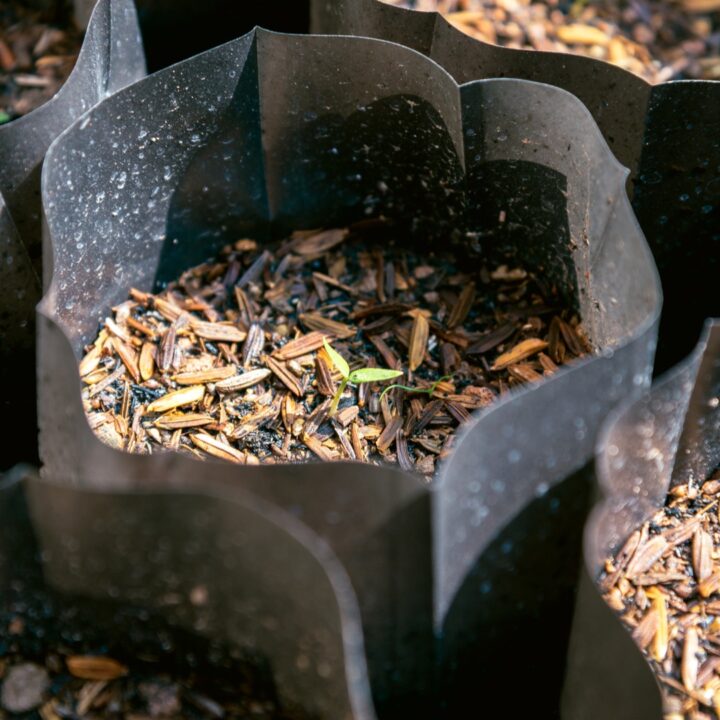Grow bags are a great option for growing tomatoes and many other crops in small spaces like a balcony or small backyard.
When the growing season is coming to a close, you may wonder: can you reuse grow bags for tomatoes? The answer is yes. Let’s find out how to store your grow bags properly to ensure they last for the next season’s crop.

Jump to: What Is A Grow Bag | Can You Reuse Grow Bags For Tomatoes? | Cleaning & Storage
This post may contain affiliate links. As an Amazon Associate, I also earn from qualifying purchases. You can read our disclosure information here–
What Is A Grow Bag?
If you’re looking for a way to grow heirloom tomatoes or other fruits or vegetables in small spaces, you’re bound to stumble upon the concept of grow bags at some point.
These fabric bags are a great alternative to traditional planters for a variety of reasons: they’re cheaper, they’re bigger, they’re easier to store, and they offer better drainage.
It’s not surprising, then, that so many balcony and small space gardeners have embraced grow bags.
If you haven’t tried them yet and are wondering if it’s for you, have a look at the full post on grow bags for tomatoes to find out everything you need to know to get started!
Can You Reuse Grow Bags For Tomatoes?
Grow bags are absolutely reusable! Most will eventually degrade as a result of sun exposure and other weather conditions, but it can be years before this happens.
This is one of the reasons grow bags are such an economical option. In addition, using a recycled grow bag is environmentally friendly as well.
Do make sure you get high-quality bags in the first place if you want to use yours for years to come.
And yes, you can also reuse grow bags for tomatoes, especially if you take care to wash and store them properly at the end of each growing season.

Can You Reuse The Soil?
It’s often recommended against growing tomatoes in the same spot year after year due to the risk of diseases, fungi and pests building up in the soil.
However, there’s also some debate about the topic: some gardeners grow tomatoes in the same garden plot without any crop rotation just fine.
I have grown my tomatoes in the same area for over 10 years, but it is important to know that I live in a climate with cold Winters, I clean the debris out every Fall, and I till in new compost every Spring.
I grow heirloom tomatoes, which are notable for having no disease resistance and have managed to have a healthy crop every August without rotation.
When it comes to using grow bags for tomatoes, I would use fresh potting soil every year. The soil is likely to be depleted of nutrients and you can’t exactly till in new compost or soil to a bag.

You could “solarize” the soil by placing it in black bags or lidded pots and then leaving them in the hot sun for a few weeks; the high temperatures should kill off most bugs and some pathogens.
Sterilizing soil by baking it in the oven is possible as well, but it does mean the helpful micro-organisms that play such a big role in our (container) gardens will be gone.
If you’re going to reuse soil, be sure to mix in some new compost to replenish the necessary nutrients.
How To Store Grow Bags
Storing grow bags is easy. Most can be folded and stored flat, making them much more efficient for storing than pots.
Just make sure you clean the bag before you store it. There are different ways to do so, but here’s a method that should work for most people:
- Remove the soil, storing it if you wish.
- Use a brush to scrub away any soil and other bits stuck to the grow bag.
- Fill a big bucket with warm water and dish soap. Many gardeners also swear by adding a tablespoon of baking soda.
- Let the bag soak and then scrub it gently with a soft brush.
- Rinse the bag.
- Important: let the grow bag dry thoroughly before storing it.
Other cleaning methods include using a pressure hose, soaking in a bleach solution or opting for hydrogen peroxide.
Some gardeners even machine wash their grow bags using a cold, gentle cycle. Whatever manages to get the gunk off is fine.
TIP: To help make your grow bags last longer, avoid dragging them across rough ground when moving them. This can damage the bottom. Instead, slide a piece of cardboard under the bag first, or use a dolly.
If you like my articles about cooking and gardening, subscribe to my weekly newsletter, where I share free recipes and gardening tutorials.


Good info. Thanks, Dorothy!
I’m going all in on grow bags this year. Dabbled in them a bit last year but really want to use them effectively this year.
I am a first timer to grow vegetables and flowers on my two terraces.Yes I picked up and got good information and Thanks for same
Thank you for commenting. Good luck and don’t let anything stop you. We’re at the mercy of the climate much of the time.